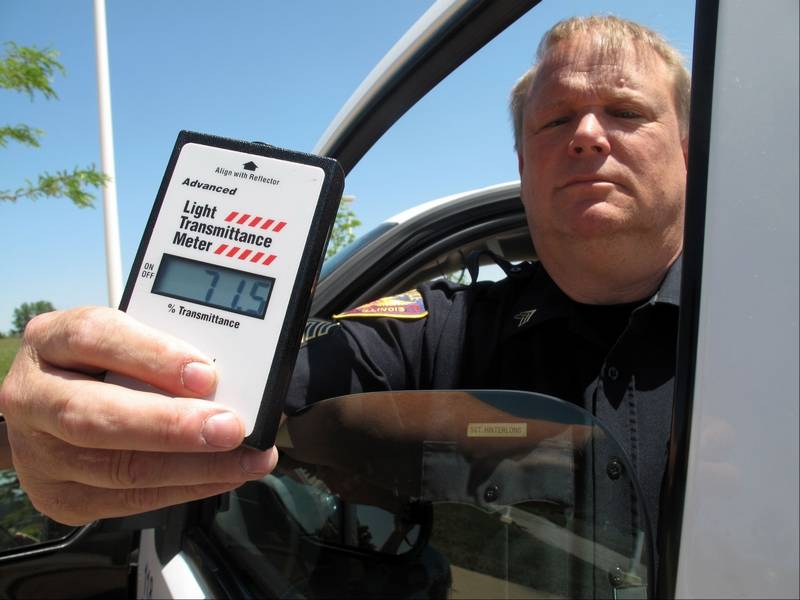Illinois Window Tinting Laws
The state of Illinois has very specific laws regarding window tinting on your car. Every state in the United States has its own percentage of darkness and reflection that your car windows are allowed to have, as well as other specific regulations you may need to know about.
Below we’ll list all relevant information pertaining to tinted windows in Illinois.
Illinois window tint laws:
Illinois window tint laws restrict windshield tint to top 6 inches. Front side windows, back side windows and rear window may have 35% VLT. On multi-purpose vehicles, front side windows may have 50% VLT, and back side windows and rear windshield can have any visible light transmission.
There are other regulations as well, including tint reflection, restricted colors and more. See below for full Illinois tint laws information!
Window tint darkness
The amount of light that can pass through your car windows is measured in percentages (called VLT), so make sure your tinting film is up to these standards! Illinois window tinting laws have different regulations for passenger and multi-purpose vehicles, so ensure you read the laws carefully and check which apply to your vehicle.
- Windshield may only have top 6 inches tinted with non-reflective tint.
- Front side windows must pass through more than 35% of light inside your car (35% VLT) on passenger vehicles, and more than 50% on MPV (bus, van, SUV, etc.; see below for more details)
- Back side windows can have 35% VLT on passenger vehicles, or may have any darkness on MPV.
- Rear windshield must have over 35% VLT on passenger vehicles, and any darkness on MPV.
In state of Illinois you can legally have up to 50% VLT on front side windows, but only if all windows behind driver are not tinted with less than 30% VLT. Furthermore Illinois tint laws allow all windows behind driver to be coated with any darkness on all vehicles, but only if front side windows are completely transparent.
What is VLT? VLT stands for Visible Light Transmittance. 35% VLT means 35% of total light must pass through windows, or no more than 65% of total light may be blocked. 5% is often referred to as “limo tint”, as it is used on limousine vehicles where nearly all light transmission is blocked.
Passenger vehicles and MPV – Multi-Purpose Vehicles have different side and back window tint restrictions. If in doubt about your vehicle type, find a federal ID label located on door frame next to driver’s seat.
Source:
- Illinois Statutes – Vehicles Code Chapter 12 Article V – Glass, Windshields and Mirrors
Window tint reflection
Some tinting film can reflect incoming light, therefore further reducing glare and heat. Illinois does not allow using tinting film with any mirrored or metallic appearance.
Side mirrors
If your car’s rear window is tinted, you must have dual side mirrors on your vehicle.
Restricted tint colors
Illinois window tint laws do not specify any window film colors which are restricted from use.
Medical exemptions
Some US states allow different window tint percentages due to certain medical conditions. If you suffer from certain qualifying medical conditions you can submit an application to use darker window film.
You can find a Tinted Window Certification form here (.pdf file). Applicant and their physician must fill and sign the form and provide it to Vehicle Services Department, Special Plates Division (contact information is in the form).
These medical conditions can include porphyria, xeroderma pigmentosa, lupus erythematosus, disseminated superficial actinic porokeratosis, albinism, severe drug photosensitivity, or others. Talk to your physician to find out if your condition qualifies.
If you receive a medical exception and are allowed special window tint, make sure the driver or other exempt passenger always has the certificate in their possession while the vehicle is in operation.
Window film certificate
In most U.S. states window film manufacturers are required to certify their film meets state standards. This is not the case in Illinois, which is good news for anyone purchasing DIY film online.
Furthermore Illinois laws do not require displaying any stickers or labels on coated windows.
Some towns or counties in Illinois may have their own special regulations about window tinting, so if you’re in doubt about anything be sure to check with your local law enforcement or DMV offices.
